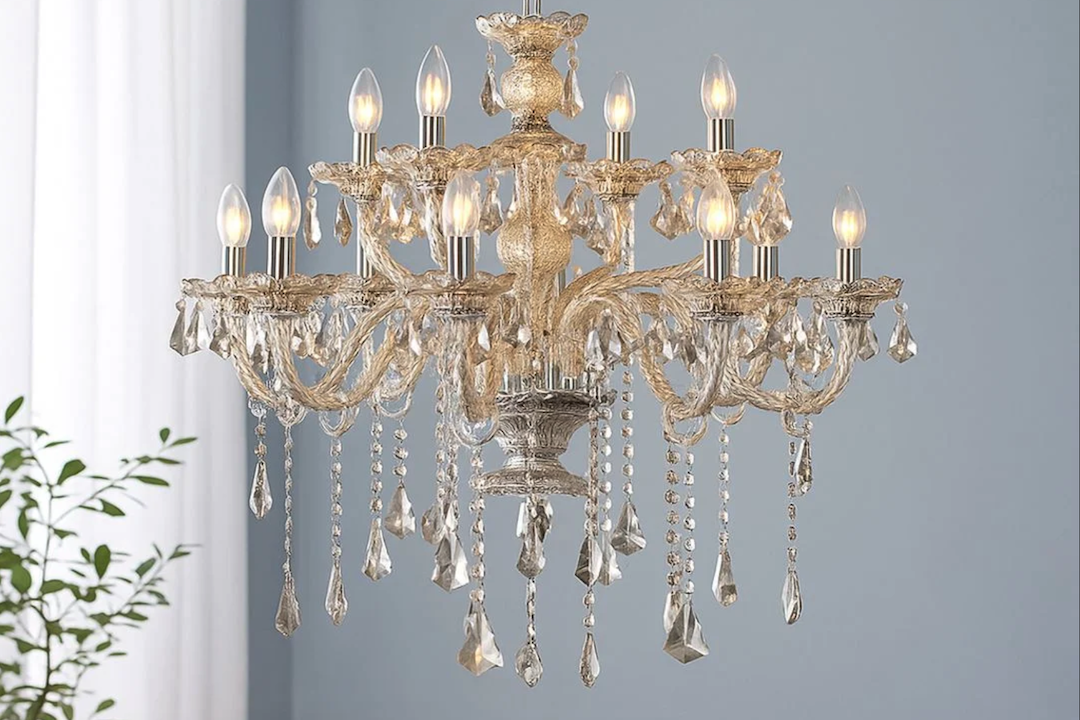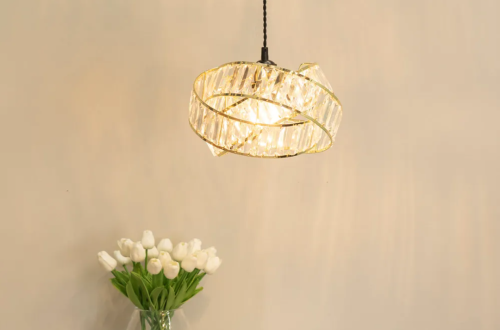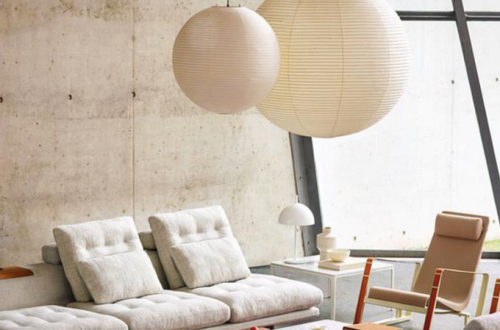
Elegant Crystal Chandelier: A Timeless Masterpiece
The history of crystal chandeliers is a fascinating journey that intertwines art, culture, and technological advancement. Originating in the medieval period, chandeliers were initially simple wooden frames adorned with candles. These early designs were functional, serving to illuminate large spaces such as churches and banquet halls.
As the Renaissance unfolded in the 15th century, the demand for more elaborate lighting fixtures grew, leading to the evolution of chandeliers Zomier into more ornate designs. The introduction of glassblowing techniques in Venice during this time marked a significant turning point. Artisans began to create intricate glass pieces that would eventually be used to enhance the beauty and functionality of chandeliers.
By the 18th century, crystal chandeliers had become synonymous with luxury and opulence, particularly in Europe. The use of lead crystal, which refracts light beautifully, became popular, allowing chandeliers to sparkle and shine in ways that captivated the elite. Notable examples include the grand chandeliers found in palaces and opera houses, such as the Palais Garnier in Paris, which features a stunning crystal chandelier weighing over six tons.
This period also saw the rise of famous glass manufacturers like Baccarat and Murano, whose craftsmanship elevated the chandelier from a mere lighting fixture to a work of art. The evolution continued into the 19th century with the advent of gas lighting and later electric lighting, which further transformed chandelier designs and their applications in both public and private spaces.
The Artistry and Craftsmanship Behind Crystal Chandeliers
Creating a crystal chandelier is an intricate process that requires a blend of artistry and technical skill. The craftsmanship begins with the selection of materials, where high-quality lead crystal is often preferred for its clarity and brilliance. Artisans meticulously cut and shape each piece of crystal to enhance its ability to refract light.
This process is labor-intensive; skilled craftsmen use diamond-tipped tools to create facets that will catch and scatter light in mesmerizing patterns. The precision involved in this stage is crucial, as even the slightest imperfection can affect the overall aesthetic of the chandelier. Once the crystals are shaped, they are often hand-polished to achieve a flawless finish.
This attention to detail extends beyond the crystals themselves; the frame of the chandelier is typically crafted from metals such as brass or wrought iron, which are then plated or finished to complement the crystals. Artisans may incorporate decorative elements such as floral motifs or intricate scrollwork, adding layers of visual interest. The assembly process is equally meticulous, as each crystal must be hung at precise angles to maximize light dispersion.
This combination of artistry and craftsmanship results in a stunning centerpiece that not only illuminates a space but also serves as a testament to human creativity and skill.
How to Choose the Perfect Crystal Chandelier for Your Space
Selecting the ideal crystal chandelier for a specific space involves careful consideration of several factors, including size, style, and function. First and foremost, one must assess the dimensions of the room where the chandelier will be installed. A common guideline is to add the room’s length and width in feet; this total should be converted into inches to determine an appropriate diameter for the chandelier.
For instance, if a dining room measures 12 feet by 15 feet, a chandelier with a diameter of approximately 27 inches would be suitable. This ensures that the fixture is proportionate to the space and does not overwhelm or underwhelm the overall design. In addition to size, style plays a crucial role in choosing a chandelier that harmonizes with existing décor.
Crystal chandeliers come in various designs, from traditional to contemporary, each offering unique characteristics that can enhance a room’s aesthetic. For instance, a classic crystal chandelier with ornate detailing may complement a vintage or traditional interior, while a sleek, minimalist design could suit a modern space. Furthermore, considering the color palette of the room is essential; clear crystals can add brightness and elegance, while colored crystals can introduce warmth or drama.
Ultimately, selecting a chandelier that aligns with both personal taste and the overall design theme will create a cohesive look that elevates the space.
The Timeless Elegance of Crystal Chandeliers in Home Décor
Crystal chandeliers have long been celebrated for their timeless elegance, making them a staple in home décor across various styles and eras. Their ability to transform a space is unparalleled; when properly placed, they can serve as focal points that draw the eye upward, creating an illusion of height and grandeur. In entryways or dining rooms, for example, a well-chosen chandelier can set an inviting tone while simultaneously showcasing the homeowner’s taste and sophistication.
Moreover, crystal chandeliers possess an inherent versatility that allows them to adapt seamlessly to different design aesthetics. Whether gracing a lavish ballroom or illuminating a cozy living room, these fixtures exude an air of refinement that transcends trends. Their reflective surfaces capture light beautifully, casting enchanting patterns on walls and ceilings that change throughout the day as natural light shifts.
This dynamic quality adds depth and interest to any room, ensuring that crystal chandeliers remain relevant in contemporary interior design while still honoring their rich historical roots.
The Versatility of Crystal Chandeliers in Different Design Styles
The versatility of crystal chandeliers is one of their most appealing attributes, allowing them to fit harmoniously into various design styles. In traditional settings, ornate chandeliers with intricate detailing can enhance classic interiors characterized by rich fabrics, dark woods, and antique furnishings. These fixtures often feature elaborate scrollwork and cascading crystals that evoke a sense of grandeur reminiscent of European palaces.
Conversely, modern design embraces simplicity and minimalism, where crystal chandeliers are reimagined with clean lines and geometric shapes. These contemporary interpretations often utilize fewer crystals or incorporate alternative materials such as metal or glass to create striking contrasts. For instance, a modern crystal chandelier might feature angular designs with clear glass accents that reflect light without overwhelming the space.
Additionally, industrial-style interiors benefit from chandeliers that blend raw materials with crystal elements, creating an intriguing juxtaposition that adds character to lofts or urban homes.
Maintenance and Care Tips for Crystal Chandeliers
Maintaining a crystal chandelier requires diligence and care to preserve its beauty over time. Regular cleaning is essential to prevent dust accumulation that can dull the brilliance of the crystals. A gentle approach is recommended; using a soft microfiber cloth or feather duster can effectively remove dust without scratching delicate surfaces.
For deeper cleaning, it is advisable to use a solution specifically designed for crystal or glass cleaning. A mixture of warm water and mild dish soap can also suffice; however, it is crucial to ensure that no moisture seeps into electrical components during this process. In addition to cleaning, periodic inspections are necessary to ensure that all crystals are securely attached and that wiring remains intact.
Over time, crystals may become loose due to vibrations or temperature changes; tightening any loose fittings will help maintain stability. Furthermore, replacing burnt-out bulbs promptly not only ensures optimal lighting but also prevents excess heat from affecting surrounding crystals. By following these maintenance tips, homeowners can enjoy their crystal chandeliers’ radiant beauty for years to come.
The Impact of Crystal Chandeliers on Lighting and Ambiance
Crystal chandeliers significantly influence both lighting quality and ambiance within a space. Their design allows for multiple light sources to be incorporated into one fixture, providing ample illumination while creating an inviting atmosphere. When lit, crystal chandeliers refract light through their facets, producing dazzling displays that enhance the overall aesthetic of a room.
This interplay between light and crystal creates an enchanting effect that can transform even the simplest spaces into luxurious environments. Moreover, the placement of a chandelier can dramatically alter how light interacts with other elements in a room. For instance, positioning a chandelier above a dining table not only illuminates meals but also fosters an intimate setting for gatherings.
In contrast, placing one in an entryway can create an impressive first impression for guests as they enter your home. The ability of crystal chandeliers to adapt their lighting effects based on placement underscores their importance in interior design; they serve not just as functional fixtures but as integral components that shape mood and experience within any environment.
The Symbolism and Prestige of Crystal Chandeliers in Interior Design
Crystal chandeliers have long been associated with luxury and prestige in interior design, symbolizing wealth and sophistication throughout history. Their presence often evokes images of grand ballrooms and opulent estates where they served as status symbols for aristocrats and affluent families. This association has persisted into modern times; even today, many view crystal chandeliers as markers of refined taste and elegance.
In addition to their aesthetic appeal, crystal chandeliers carry symbolic weight within various cultural contexts. In some traditions, they represent enlightenment and clarity due to their ability to refract light beautifully. In others, they may symbolize celebration and festivity; their sparkling presence often graces weddings and special events where joy is paramount.
This multifaceted symbolism enhances their allure in interior design; incorporating a crystal chandelier into one’s home not only elevates its visual appeal but also imbues it with deeper meaning—transforming an ordinary space into one filled with history, elegance, and significance.





